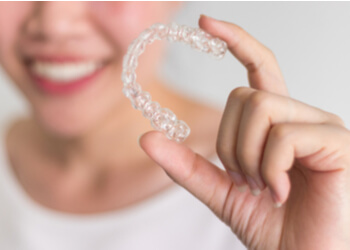Orthodontic treatment has traditionally been associated with children and young people; however, more adults are opting to tackle orthodontic issues with the help of dental professionals. These days it’s not uncommon to see people of all ages wearing conventional braces or clear aligners.
Teeth and bite misalignments are incredibly common among both adults and children and can lead to a myriad of dental health problems. Therefore orthodontists and dentists are incredibly pleased with the increased popularity and acceptance of orthodontic treatment.
When it comes to orthodontics, these days, we are lucky to have various treatment options. Having said that, if you think that you or your children need orthodontic intervention, you may be feeling confused about the different treatments available. To help clear things up, we have compiled a simple evaluation of clear aligners vs braces.
What Problems does Orthodontia Solve?
Dentists use clear aligners and braces to solve numerous orthodontic problems such as:
- Misaligned bites including:
- Open bites – where the front teeth don’t meet when the mouth is closed.
- Overbites and underbites – these terms refer to the vertical overlap of the with the upper or lower front teeth over the other.
- Overjet – this term describes the horizontal distance between the upper and lower front teeth.
- Crooked teeth – clear aligners and braces are the best way to achieve teeth straightening.
- Crowded teeth – this can occur either when the patient’s mouth is too small for all their adult teeth or if the patient has extra teeth.
- Diastema – space between teeth.
- Periodontal issues – problems such as misaligned teeth can make it difficult for patients to brush and floss their teeth well, which can lead to gum disease and other oral health issues.
- Speech problems – improvements to teeth alignment and spacing can solve various speech issues as it can affect the tongue’s movement.
- Confidence – many patients with orthodontic problems struggle with low self-esteem. Improving the aesthetics of your teeth can help you smile with confidence.
Clear Aligners vs Braces: The Pros and Cons
Now that we’ve discussed how orthodontic treatment can help you, from teeth straightening to confidence building, let’s examine the pros and cons of each method.
Visibility
Despite the increased popularity of braces among adults, many people remain concerned about the stigma of wearing braces while others simply don’t like the way traditional braces look.
It’s undeniable that one of the most significant benefits of clear aligners is the fact that they appear invisible so you can tackle your orthodontic issues without worrying about aesthetics. In fact, an added benefit is that clear aligners can also help hide existing gaps.
While many adults and adolescents prefer clear aligners for their invisibility, some children enjoy the fact that the elastics on traditional braces can be customised with their favourite colours.

Comfort
Another area where clear aligners have the edge over braces is comfort. Although both treatments can cause some discomfort from tooth movement, clear aligners are much more comfortable than braces. Some patients with braces experience pain, discomfort, and mouth sores from the wires and brackets.
Eating and Drinking
When it comes to the topic of eating and drinking, comparing clear aligners vs braces gets a little complicated because there are definite pros and cons on both sides.
Because clear aligners are removable, you can take them out to eat and drink. In fact, you must take them out if you’re going to consume anything other than water, as the aligner tray can stain. Having to remove your aligners every time you want a cup of coffee or a snack can be annoying, but the alternative may be worse.
When you’re wearing braces, there are certain foods you just can’t eat, either because they can damage the brace or get stuck in it. In most cases, this means avoiding hard foods like nuts and sticky foods such as gum. Aligners, on the other hand, don’t require you to change your diet.
Cleaning
It’s indisputable that having clear aligners involves more cleaning, both of your teeth and the aligner trays themselves, than braces. If aligners are not adequately cared for they can become discoloured and unsightly and, even worse, a buildup of bacteria can damage your teeth.
Your dentist will discuss the specifics of your cleaning routine and any products you may need with you. Still, generally, patients with clear aligners should clean both their teeth and the aligners each time they are removed for eating or drinking, as well as soaking them once a day.
Braces do not involve as much cleaning; however, brushing and flossing your teeth can be more challenging with braces than aligners. Ask your dentist for advice about how you can maintain your oral hygiene while wearing braces.
Speed
The time it takes for orthodontic treatment to be completed varies from patient to patient, but it is generally acknowledged that clear aligners usually take a shorter treatment time than braces. Aligners are typically used to correct minor to moderate and cosmetic orthodontic issues.
A Personal Choice
As you have seen from our evaluation of clear aligners vs braces, when it comes to methods of teeth straightening, there are many factors to consider. There are many more issues you will need to take into account when making your decision, such as cost and the specific orthodontic problem you are trying to fix. Discussing these with your dentist is crucial.
Unless there is a medical reason why your dentist believes that one treatment would be more successful than another, choosing between clear aligners and braces is largely a personal choice. Ask yourself questions like ‘is invisibility important to me?’, ‘do I mind giving up certain foods?’, and ‘will I remember to stick to my cleaning routine?’ and be honest with the answers.
Orthodontic Treatment you can Trust
If you are looking for teeth straightening solutions from experienced, highly-skilled dental professionals, Sydney Smile Care is here for you. Our staff are experienced in all orthodontic options and are dedicated to helping you achieve better oral health and a smile you can be proud of.
Call us on (02) 9747 1988 to book your consultation and learn more about how Sydney Smile Care can help you.


Recent Comments